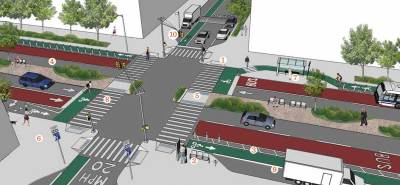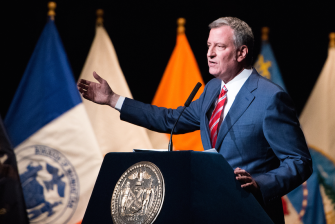TA: Quicker Action on Vision Zero Can Save Thousands of Lives

The de Blasio administration is making progress on street safety, but not fast enough to achieve the mayor’s Vision Zero target of eliminating traffic deaths by 2024, Transportation Alternatives says in a new report. At the current rate of improvement, it will take nearly 40 years to reach that goal.
Advocates from TA, Families for Safe Streets, and other groups took to the steps of City Hall this morning to call for swifter, more aggressive action from city and state officials.
TA Executive Director Paul Steely White said the city needs to cut traffic fatalities by 40 percent per year — as opposed to the present rate of 10 percent.
“We’re here to say that Vision Zero is working, but Vision Zero isn’t working fast enough,” White said, adding that there are “scores of ways the mayor, his agencies, and other key players can do a better job implementing Vision Zero and deliver Vision Zero on time so we can save lines.” Among those recommendations — budgeting more resources for DOT to implement street redesigns.
Released this morning, TA’s 2015 Vision Zero Report Card grades elected officials and public agencies on their street safety performance.

According to the report, only 22 percent of the city’s 154 priority corridors have received safety improvements — and only three of those corridors were redesigned along their entire length. Given those numbers, White said the city needs to start setting annual Vision Zero benchmarks to assess its street safety policies and practices.
While commending de Blasio for making progress, White called out the administration for shortchanging street redesigns. “At the current rate, the DOT only has funding to fix a fraction of those dangerous streets during the year,” he said.
When DOT does have the resources to redesign a street, the agency needs to be bolder, the report says:
The agency’s approach in 2015 was more reactive than proactive. With a pattern of implementing piecemeal improvements where wholesale redesigns are needed, and a willingness to let their safety expertise be overridden by local community boards.
The report argues that de Blasio “brought less fervor to Vision Zero initiatives than in 2014.” At the press conference, White called on the mayor to increase funding for DOT’s “operational” budget, which would allow the department to more rapidly make inexpensive but effective changes to the city’s most dangerous streets and intersections.
TA’s Vision Zero Investment Report, released last year, called for a $50 million annual investment in DOT operational projects and an additional $2.4 billion in capital funding over the next ten years. The mayor will release his preliminary FY16 budget tomorrow.

The report also criticizes NYPD and Police Commissioner Bill Bratton for not doing enough to enforce traffic laws. Bratton was conspicuously absent from the mayor’s press conference yesterday, which TA says reflects his disinterest in safer streets. “There are 4,000 hit-and-run incidents every year that result in injury, and only a fraction of those — fewer than 100 — are even prosecuted or charged,” White said this morning. “Because there’s no evidence. Because cops are not investigating those crashes.”
Also speaking today were members of Families for Safe Streets, Manhattan Borough President Gale Brewer, Tri-State Transportation Campaign Executive Director Veronica Vanterpool, and seven members of the City Council.
Among them was Council Member Helen Rosenthal, who represents the Upper West Side, where the Community Board 7 transportation committee recently deadlocked over a complete street redesign of Amsterdam Avenue.
“I was appalled at that decision,” Rosenthal said. “It’s absolutely not acceptable for community boards, who as Paul described are ill-educated about what is needed to make a safe street, to be the only arbiter of having that safe street go through. While I understand that DOT likes to work with the community to install safe streets, the community board, we all have to remember, is advisory only.”


